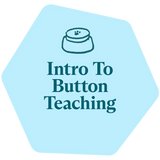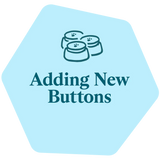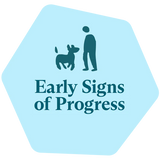Does your learner come running when you shake their treat container? Are they willing to drop everything for a good game of tug? What about rolling over for belly rubs?
Early button presses are often requests—your learner wants something, and they learn that pressing the button can express that desire. Finding out what motivates your learner is key to encouraging button use.
Motivating your learner refers to activating, creating, or capitalizing on their desire to do something. A learner who is motivated has a good reason to do something. Keep in mind that what you think is a good reason, might not be what they think is a good reason.
Proper motivation is essential because it ensures the learner actually wants to learn.

|
Not all petting, food, or play is created equal in the eyes of most learners.
Learners have personal preferences, go through moods, and change their minds just like us. Motivation levels will differ depending on factors like how hungry they are, how much exercise and mental stimulation they’ve had, and how much quality time you’ve spent together recently.
There may be learners who are super motivated by anything and everything, but these are few and far between. Some learners, such as cats and primitive breed dogs, can be more difficult to figure out motivators for but that’s why we are testing a bunch so don’t give up— get creative and explore!
Pro Tip: Novelty can be a huge motivation booster. A motivator’s “new factor” can be maintained by rotating them out every few weeks. If chicken is always offered, mix it up with some beef. If they have a huge collection of toys, pick 5 to have out at a time and then rotate. Maybe there’s a particularly motivating toy that gets brought out for special occasions, such as button-teaching modeling games!
Types of Motivators
When it comes to teaching animals, the three most common motivators are physical affection, play and food. Walks and outside access are other potentially strong motivators.Reality check: Don’t just decide you want a learner who is motivated by physical affection and praise alone because you think they should just inherently want to please you. That’s not how this works. If it turns out that IS what is most motivating to your learner, that’s great and super convenient for you. But please explore other types of motivators with an open mind.
Learn more about:
Note: a printable version of the following activities is available here.
1. Physical Affection
Does your learner like chin scratches? Or are they more of a cuddler? Some learners are more particular than others when it comes to where and how they like to receive physical affection, and this might vary depending on their mood or environment. You might find they don’t like their head or face touched while they’re focusing intently on something. Even if they love belly rubs, they might not want to expose this vulnerable area during high-energy or stressful moments.
Never force physical affection upon your learner. If they aren’t enjoying it, it isn’t doing anything positive and will only harm your relationship with them.
Some learners do not like their legs or feet touched, especially if they experience joint pain. Most learners won’t like their tails touched as this is an extension of their spine making it a highly sensitive and vulnerable area. Many cats highly dislike people trying to touch their belly.
Pay attention to how they respond when you go to initiate physical contact with them to determine what type of affection is most motivating for them.

|
Signs they like it:
- Leaning into you, moving closer, or bumping your hand to indicate they want more
- A relaxed posture and “happy face” expression (relaxed eyes, ears, and mouth).
- Purring or leg thumping
 |
Signs they don’t like it:
- Moving away immediately when experiencing this type or location of touch
- Avoiding your hand if you go to reach for them again
- Tensing up and other stress behaviors (e.g., looking away from you, yawning, beginning to pant, etc.)
Physical Affection Test
Test and rank 4 forms of physical affection you think your learner might enjoy. You can use the suggestions listed or cross them out and list your own. Even if you know already, this exercise is still an excuse to give your learner lots of love, so give it a try.
How much does my learner seem to enjoy each form of attention? (circle one for each type of petting)
| Back pets: | didn’t care | liked it | loved it | loved it the most |
| Butt scratches: | didn’t care | liked it | loved it | loved it the most |
| Ear scratches: | didn’t care | liked it | loved it | loved it the most |
| Belly rub*: | didn’t care | liked it | loved it | loved it the most |
| *Chin/cheek rub for cats | didn’t care | liked it | loved it | loved it the most |
Types of physical affection to consider testing: chin & cheek rub, behind the ears & neck scratches, armpits & belly rubs, back & side strokes or pats, and butt/hammy scratches.
2. Play

|
If your learner has more fun playing with boxes than their new toy, you might already know that play preferences can be interesting (and strange!). Experiment with different types of toys as well as different types of games you play with them to find the ultimate winning combination(s). Try to identify which of their playtime toys and activities are most enticing—they might end up becoming quickly-learned button words.
Different learners have different preferences. Some prefer a game of fetch over a game of tug. Some might rather play on their own with a mouse toy or a feather wand. Toy texture, shape, and hardness all affect your learner’s playtime experience. Some toys crinkle, squeak, or jingle which they may like or dislike. Generally, dogs like holding and playing with toys that feel comfortable in their mouths. Toys that have a bit of give are a big hit with learners that like to self-soothe by flexing and unflexing their jaws around it. Cats tend to enjoy toys that are light enough to bat around or that feel good to hug and kick.
Tug Toy Selection for Dogs
- Needs to be strong and durable…for obvious reasons. Rope toys are generally a safe bet.
- Allows ample space between your hand grip and your learner’s mouth grip. The more excited they are, the harder it is to be careful with their teeth.
- Should be comfortable for both you and your learner to grip. If they are constantly readjusting their mouth grip or are hesitant to engage in the game that may indicate some discomfort with the toy you’ve selected. They should be able to bite down firmly to grip their end without constant readjustments. Body size and mouth shape will likely affect what size and shape will be most comfortable for your learner to hold. A Boston Terrier with a short, rounded mouth might want a rounder grip. A long-snouted German Shepherd, on the other hand, may want a wider, flatter grip.
- Material matters. Some dogs are hard-mouthed, and some are soft-mouthed. Every learner is different!
DIY Make your own tug toy by rolling a towel and duct-taping segments. Use an old bath or beach towel for larger learners and a hand towel for smaller ones. Making your own also allows you to adjust how round or flat and firm or soft the toy is depending on how tightly you roll versus fold it. You can also try cutting fabric into strips, braiding it, and knotting off both ends.
Teaser Selection for Cats
- Needs to be long enough to allow you to move it quickly in enticing patterns. Try different speeds and types of movement. Incorporate long pauses in between simulating small scurrying movements
- Some cats like chasing things in the air, as if they are birds, while others are ground chasers as though they were hunting a snake or a mouse.
- Ribbons on sticks, feathers, bells, spiraled pipe cleaners, or a bell on the end of the wire are all things that might attract a cat’s attention.
DIY Make your own teaser wand for your cat by cutting an old t-shirt or towel into thin strips and braiding it into a long rope. If your cat seems more air driven, you can attach that to a dowel, stick or even an empty paper towel or wrapping paper tube.
Safety Alert: Never leave your learner alone or unsupervised with homemade toys as string, ribbon, or strips of fabric can be dangerous if ingested.
Play Test Activity
List 4 of your learner’s favorite toys and/or games that you want to test, like ball, tug, flirt pole, teaser wand, mouse toy, squeaky toy, etc. If you’re ready to take it to the next level, get really specific and list combinations of the toy and type of game played for testing such as: squeaky ball + fetch game, crinkly toy + tug game, rope toy + tug game, tassel toy + flirt pole game, etc.
Note: while puzzles and other solo enjoyment games are very valid stimulation activities, we are trying to identify and test viable forms of interactive play or play that involves you as part of what makes it fun.
How excited did my learner get when I showed, offered and we played with this? (circle one for each)
| Toy Test #1: ___________________ | didn’t care | liked it | loved it | loved it the most |
| Toy Test #2: ___________________ | didn’t care | liked it | loved it | loved it the most |
| Toy Test #3: ___________________ | didn’t care | liked it | loved it | loved it the most |
| Toy Test #4: ___________________ | didn’t care | liked it | loved it | loved it the most |
3. Food

|
Watch out for Food Frenzy! Food can be one of the most powerful motivators, but it isn’t always the best place to start when teaching buttons. For some learners, food is too motivating. For overly food-motivated learners, starting with TREAT can be counterproductive. Rather than learning that buttons are for communication, they might fixate on TREAT and believe they are just magical food dispensers.
With great motivation, comes great responsibility...
Using food as a motivator may get quick results, but could cause issues for some. Depending on your learner, consider other approaches before introducing edible concepts. Concepts like TRICKS or TRAINING where learners can ask for the opportunity to earn food through interactive exercises with you might be a good way to ease into food concepts when the time comes.
That being said, learners who are more difficult to motivate will benefit greatly from starting with food.
If food is appropriately motivating to your learner:
- Cut treats into small pieces. The smaller the pieces, the more repetitions of button presses you can do.
- Not all food is equally motivating. Some learners will work for their regular kibble or half a baby carrot while others require bits of cooked chicken or steak. Don’t automatically choose the most motivating item, find the sweet spot where they want to learn but don’t become frantic about getting a treat.
Safety Alert! Never feed your learner anything from the allium family (garlic, onions, chives, leeks, scallions, shallots), macadamia nuts, poultry bones, chocolate, grapes (or raisins), and check ingredient lists to avoid xylitol, BHA or BHT. Many dogs and cats are lactose-intolerant, so take it easy with dairy products too.
Food Test Activity
List 4 types of edible rewards you want to test with your learner. Examples include pieces of kibble, cooked chicken, cooked beef, cooked turkey dog bits, lactose-free cheese, any variety of store-bought treats, baby food (carrot is often popular), etc.
How excited did my learner get when I showed, offered and they tasted this? (circle one for each)
| Food #1: ___________________ | didn’t care | liked it | loved it | loved it the most |
| Food #2: ___________________ | didn’t care | liked it | loved it | loved it the most |
| Food #3: ___________________ | didn’t care | liked it | loved it | loved it the most |
| Food #4: ___________________ | didn’t care | liked it | loved it | loved it the most |
Relationship Between Arousal & Learning
A certain level of excitement or arousal can have a positive impact on performance. This relationship is known as the Yerkes-Dodson Law. However, once the optimal level of arousal and consequential performance is reached, increasing arousal further actually decreases performance.
 |
It’s more difficult for the brain to process information when it’s too stressed, whether it’s “good” stress (eustress) or “bad” stress (distress).
“Overaroused” Overarousal is a state of increased excitement or stress. Learning performance begins decreasing as they become more frantic and reactive as their attention and self-regulation fade away. You’ll often see a burst of energy where they get the zoomies or begin acting silly. In reactive learners, this is your warning stage as they approach the drop off of going over threshold.
“Over threshold” If an individual crosses into what is referred to as “over threshold” then they are beyond their own ability to cope and regulate in the given situation and there is a drop off of performance altogether. The animal is no longer in a learning mindset at this point and needs support and help mitigating arousal levels to return to baseline.
Did you know? A lot of "problem behaviors" or "reactivity" is really just misunderstood manifestations of arousal in an individual who struggles to self-regulate and needs help developing those calming skills so they can live their life to the fullest.
How to Pick Motivators for Button Teaching
So now you understand that a certain level of excitement can be good for learning, but it becomes more difficult for an overwhelmed brain to process information. The key to successful button teaching is finding that sweet spot:
Give your learner buttons they really want to use but won’t completely lose their mind over.
The most effective motivators for early button teaching generally fall between “Reasonably Motivating” and “Super Motivating” for most learners. For learners who struggle with impulse control or self-regulation, concepts that are “Too Motivating” may not be the best beginning buttons. For these learners, even concepts that are “Super Motivating” may be best to wait to introduce until after they’ve learned the basics and you’ve been able to introduce ALL DONE and/or LATER.
 Too Motivating:
Too Motivating:
They may:
- lose control of themselves and appear clumsy or wild
- struggle to perform basic behaviors such as “sit”
- frantically offer known behaviors trying to get more
- be so focused on the motivator they can’t think straight: “They can’t hear you”
- be reacting more than thinking (all output, no input)
Not necessarily the best motivator for starting button teaching.
 **Super Motivating:
**Super Motivating:
They may:
- be willing to do anything for this motivator, even things they dislike.
- show reduced bodily control or spatial awareness and might bump into things.
- be unwilling to quit even when the motivator is done/gone/put away
- dance along the boundary of overarousal but still be able to function/think
They’re extremely focused on the motivator but not necessarily on learning. A powerful motivator for button teaching but be ready and willing to respond and model a lot!

*Very Motivating:
- They’re willing to do just about anything for this motivator
- They’re happy to try new things and remain focused
- They’re attentive and listening when this motivator is available.
Often the best motivators for starting button teaching!

*Reasonably Motivating:
- They’re happy to work for and do as asked for this motivator
- They enjoy learning new things or engaging with you with it
- They may still be distracted by what’s happening around them and could be slower to respond.
A good motivator for button teaching.

Somewhat Motivating:
- They’re willing to do as asked for this motivator, as long as it doesn’t take too much effort or last too long.
- They’re likely to lose attention quickly
- They’re unfocused, relaxed, or “chillin”
Not a great motivator for starting button teaching.

Not Motivating:
- They’ll accept or interact with the motivator but wouldn’t necessarily do anything for it
- They may not even be interested in it at all
Not even motivating…
Some learners don’t have anything that is “Too Motivating” while others are overexcited by everything. Unsure if something is “Too Motivating” for your learner? If you have to ask then it’s probably only “Super Motivating.” Because trust us, you’ll know when you see it.
Take the guesswork out of choosing starting button concepts and set your learner up for success:
Let’s fill out a personalized Motivation Tower for your learner!
To rank potential motivators on your learner’s motivation tower accurately, you’ll need to test different types of motivators. We’ve included instructions and printable activities for you here: My Learner’s Motivation Tower Activity
If you have questions or feedback regarding this content, please email us at learning@fluent.pet













Leave a comment
This site is protected by hCaptcha and the hCaptcha Privacy Policy and Terms of Service apply.